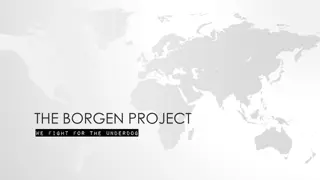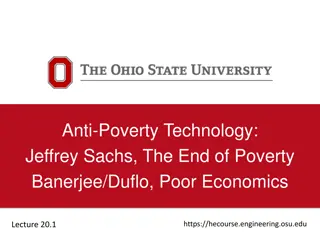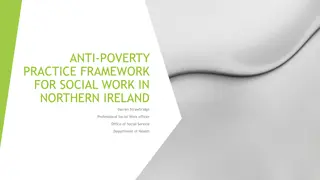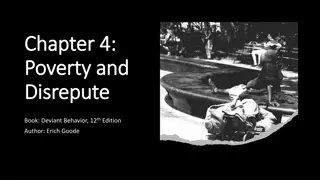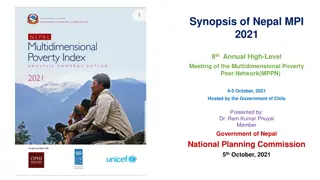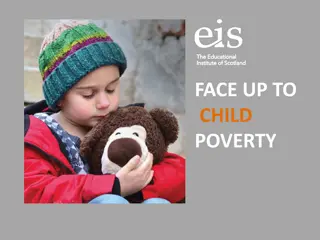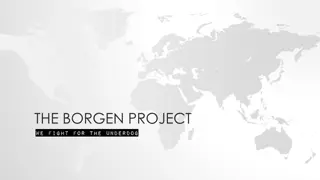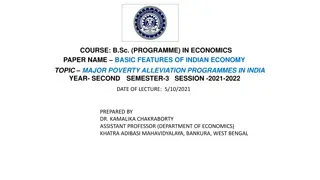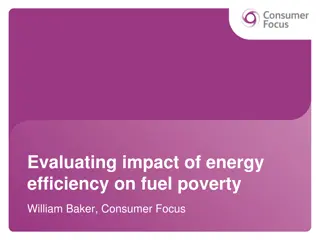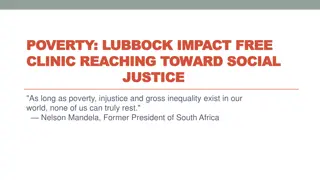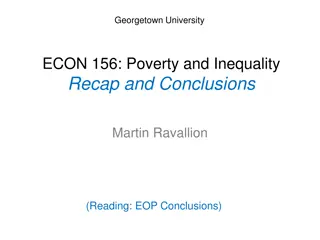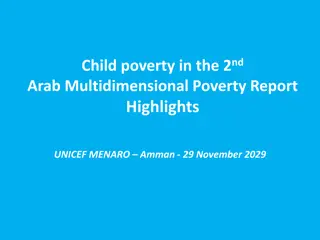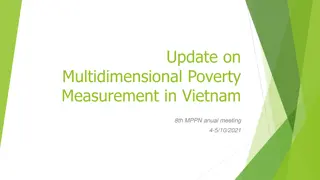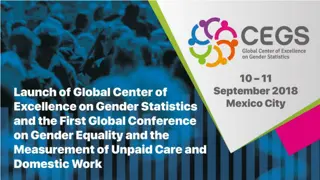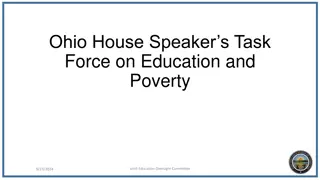Ending Poverty in Possible.
Poverty in America is a complex issue that spans generational, situational, urban, and rural contexts. This presentation delves into the various types of poverty, such as absolute, relative, and generational, and explores the initiatives undertaken, like LBJ's War on Poverty in 1964, to address and alleviate its impact on society. By defining, categorizing, and examining poverty through a historical lens, we aim to foster a better understanding of the root causes and potential solutions to this pervasive social problem.
Download Presentation

Please find below an Image/Link to download the presentation.
The content on the website is provided AS IS for your information and personal use only. It may not be sold, licensed, or shared on other websites without obtaining consent from the author. Download presentation by click this link. If you encounter any issues during the download, it is possible that the publisher has removed the file from their server.
E N D
Presentation Transcript
Poverty in America Midwestern State University Lifelong Learning Center Emily Klement, Ed.D. Executive Director Northwest Campus May 2, 2019
How do you define poverty? Merriam-Webster the state of one who lacks a usual or socially acceptable amount of money or material possessions Overcoming poverty is not a gesture of charity. It is an act of justice. It is the protection of a fundamental human right, the right to dignity and a decent life. Nelson Mandela, former President of South Africa.
Six Types of Poverty Absolute Extreme kind of poverty involving the chronic lack of basic food, clean water, health and housing Long-term in nature; generational Not common in the developed world Relative refers to the economic status of a family whose income is insufficient to meet its society's average standard of living Situational Is generally caused by a sudden crisis or loss Is often temporary.
Six Types of Poverty (cont.) Generational Occurs in families where at least two generations have been born into poverty Families living in this type of poverty may not be equipped with the tools to move out of their situations Urban Occurs in metropolitan areas with populations of at least 50,000 people Chronic, acute stressors Rural Occurs in nonmetropolitan areas with populations below 50,000 Less access to services
LBJs War on Poverty In 1964, roughly 20% of Americans were poor or living in poverty 1964 State of the Union address "Our aim is not only to relieve the symptoms of poverty, but to cure it and, above all, to prevent it. Cause of poverty not personal moral failings of the poor but as a societal failure Part of a larger legislative reform program, known as the Great Society Set of initiatives proposed by Johnson administration, passed by Congress, and implemented by Cabinet agencies Faced immediate opposition Focused on four pieces of legislation
LBJs War on Poverty (cont.) Programs Social Security Amendment of 1965 Medicaid Medicare Elementary & Secondary Education Act of 1965 Title 1 Program Economic Opportunity Act of 1964 Job Corps VISTA Office of Economic Opportunity Food Stamp Act of 1964 Made program permanent
Results Between 1964 and 2014, 22 Trillion have been paid by US taxpayers This does not include Social Security or Medicare payments In FY 2018 total US government spending on welfare federal, state, and local was guesstimated to be $1,091 billion, including $642 billion for Medicaid, and $449 billion in other welfare Let s Compare Year Total US Population % Living in Poverty Population Living in Poverty 1964 191,000,000 19.00 36,461,000 2016* 323,400,000 12.7 40,600,000 * This is the most current date for when data is available
Measuring Poverty Levels US Census Bureau Agency in charge of determining poverty levels Official Poverty Measure (OPM) Pre-tax cash income Threshold of 3 times minimum food diet in 1963 Adjusted for family size Supplemental Poverty Measure (SPM) Introduced in 2010 to provide alternative view on measuring poverty levels More reflective of 21stCentury America Does not replace the OPM
What Does Poverty Look Like Today? In 2019, this is what being poor looks like by Federal Government standards: Household/ Family Size 100% of Federal Poverty Level 130% of Federal Poverty Level 138% of Federal Poverty Level 1 $12,490 $16,237 $17,236 2 $16,910 $21,983 $23,336 3 $21,330 $27,729 $29,435 4 $25,750 $33,475 $35,535
Poverty by the Numbers (cont.) State of Texas 2017 Total Population 27,336,443 Population in Poverty 4,261,337 Ranked 39thout of 50 Adults Working Aged Men 11.5% (28th) Working Aged Women 15.9% (35th) Children 22% (38th) By Race/Ethnicity African American 20.4 Asian 10.7 Caucasian 14.6 Latino 22.3 Native American 18.8 TalkPoverty.org
Poverty by the Numbers (cont.) Wichita Falls In 2017, 20.9% of residents were in poverty Compared to the state average of roughly 16%
Walk in the Shoes of the Poor http://playspent.org/html/ Reflections
Benefits Cliff Working poor families may qualify for Work Support Benefits Medicaid Child Care Assistance Earned Income Tax Credits (EITC) Regulations connected to Safety Net Program Can trap people in poverty $1 per hour increase may cause people to lose benefits Effect happens to those near the poverty line Can discourage people from engaging in workforce development programs or from even seeking employment in the first place Work DOESN T always pay
So What Can Be Done? Increase minimum wage in tandem with other changes Living wage income http://livingwage.mit.edu/counties/48485 Shift in thinking Moving away from one time assistance Transactional relationships to Transformational relationships Legislative Changes Changes in state regulations may help reduce the impact of families working their way out of poverty Colorado s Child Care Assistance Cliff Effect Pilot Program Maryland s Governor s Executive Order 01.01.2017.03 Texas House Bill 1483
Intervention Strategies Case Management Is a collaborative process of assessment, planning, facilitation, care coordination, evaluation and advocacy for options and services to meet an individual s and family s needs Underlying premise is when someone reaches their optimal level of functioning, everyone succeeds Serves as means for people to achieve self-sufficiency Works best with open and ongoing communication exist between the client and the case manager Is holistic Dual Generation Services Education
Intervention Strategies (cont.) Padua Pilot Program of Catholic Charities Fort Worth Three components Assessment of various dimensions Assigned two person Case Management team Temporary & strategic financial assistance to address barriers to self- sufficiency Results Participants on average: have increased liquid assets by $5,000 decreased debt by $2,000 experienced 23% increase in full-time employment Partner with the University of Notre Dame https://www.catholiccharitiesfortworth.org/padua/
Intervention Strategies (cont.) Dual Generation Strategies Focuses on strategies that address both the parent and child Combining the interventions to break the cycle of poverty Creates a legacy of economic security that passes from one generation to the next Emphasize: education economic supports social capital health and well-being
Rural Vocation Program The Rural Vocation Program exists to provide individuals with opportunities to further their education through community colleges in order to secure a living wage employment, experience financial security and get out of poverty once and for all. Program began in 2015 and continues to grow each year. RVP assists with tuition and school-related costs; provides limited emergency financial assistance to remove barriers to completing their educational goals and provides a navigator to assist the students throughout program participation. As of Fall 2019, there are CCFW RVP navigators on 8 community college campuses throughout the 28 county Diocese of Fort Worth. The RVP reports a 92% completion rate; comparatively, the state of Texas community colleges report a 13% completion rate. The program is competitive and assistance is offered to a limited number of participants. The impact of the program is not only on the students lives, but also for their families, which finally ends generational poverty. University of Notre Dame research: A community college is the greatest intervention into eradication of poverty (Lab for Economic Opportunity, LEO).
Research-Based Models Do Work The more educated someone is the less likely it is that they will live in poverty. Poverty Rates are 5% for people with a bachelor s degree or higher, 10% for people with some college but no degree, 14% for people with a high school diploma and no college and 29% for people with no high school diploma. LEO works with education partners to identify and evaluate programs that increase success in school from early childhood to adulthood. Featured projects include Stay the Course , a community college completion program designed to help low-income students overcome the non-academic barriers that often lead to students dropping out of school. Stay the Course College, Fort Worth, as a model of intervention: Community college graduation rates nationwide are tragic. We started asking why and then we figured out how to fix it. has been implemented as a research-based program at Tarrant County We partnered with the Wilson Sheehan Lab for Economic Opportunities (LEO) at the University of Notre Dame to create Stay the Course how case management can help low-income students persist in school and ultimately graduate, equipping them with credentials that increase earning power. (STC), a research project to evaluate Money is only of the problem. Nonacademic personal obstacles, social and institutional obstacles, and academic preparation are the other barriers. That s where we fit in- to capture and support some of the non-academic obstacles to success (CCFW website, 2019).
The cost of poverty is carried by more than the poor. It robs society of productive potential. It wastes money on ineffective programs. It silences the voices of those with the most to say.
Emily Klement, Ed.D. Executive Director Catholic Charities-Fort Worth Northwest Campus 905 Holliday Wichita Falls, TX 76301 eklement@ccdofw.org



